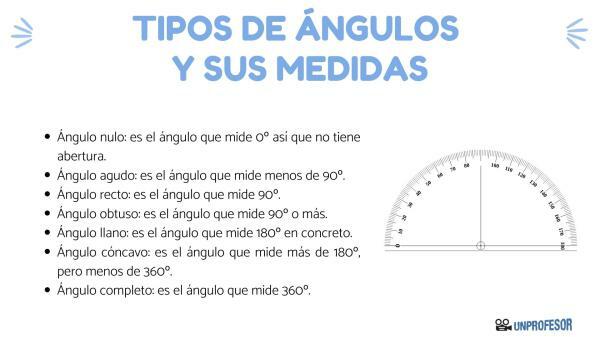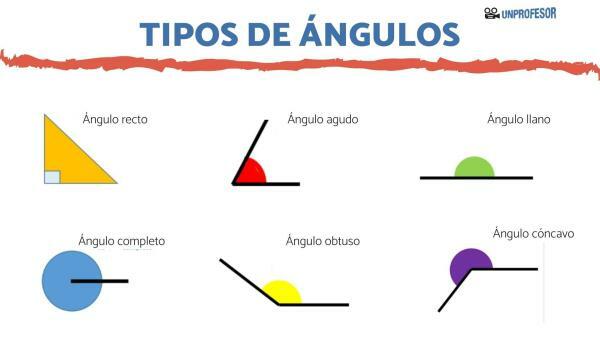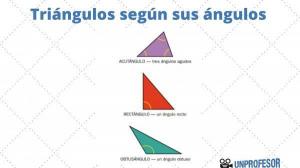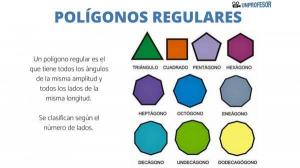Angles types and their measurements

Today, we are happy to bring you a new math lesson from a Teacher, in this case on types of angles and their measures. To do this, we will start by looking at what an angle is, what types it can be and what measures each of the different types has. At the end of the article you will also find a proposal for exercise with its respective solution, so that you can verify that you have understood what was explained.
Index
- What are angles and examples?
- What are the types of angles according to their measure?
- Exercise of the types of angles and their measures
- Solution
What are angles and examples?
An angle is the resulting amplitude between two lines joined by a vertex or point of attachment that is measured in degrees or radians, usually.
To measure angles it is very useful to have a handy protractor, which is usually a semicircle and, therefore, is capable of measuring up to 180º, although sometimes it is a complete circle and can be used to measure up to 360º. It is also important to mention that for each pair of lines that an angle forms, two angles are actually created (the interior and the exterior).
The elements of an angle are:
- Its two sides
- Its two angles
- Its vertex or point of attachment
Examples of angles
This may seem too theoretical, but the truth is that we find angles in our daily life at every moment, with the portions of a cake, with the hands of a clock ...

What are the types of angles according to their measure?
Next, we are going to discover you which are the different types of angles and their measures. Here is a list of all of them:
- Null angle: it is the angle that measures 0º so it does not have an opening, since the two lines are together one above the other without there being any gap between them.
- Acute angle: it is the angle that measures less than 90º, so it will be more closed than a right angle, as we will see next.
- Right angle: is the angle that measures 90º. To easily recognize it, we can remember the corner of a square or rectangle.
- Obtuse angle: it is the angle that measures 90º or more, so its opening is greater than that of a right angle, but less than 180º, so we can say that it is more closed than the straight angle, as we will now see.
- Plain angle: it is the angle that measures 180º in particular and it is very easy to identify because it looks like a straight line.
- Concave angle: it is the angle that measures more than 180º, but less than 360º, so it is greater than an obtuse angle, but less than the full angle, which is the one that we will see next.
- Full angle: is the angle that measures 360º. It is related to the null angle, in the sense that visually they appear the same, but they are had as opposite sides to the lines. In other words, in this case it is about looking at the outside of the lines.
Along this line, we have already explained the angles from smallest to largest aperture in order: null, acute, right, obtuse, flat, concave and complete.
Exercise of the types of angles and their measures.
We now suggest that you solve the following exercise, so that you can check if it is clear to you what types of angles exist and what their measurements are. In the end you will be able to find the answers.
1. Create a table with 7 columns, one for each type of angle, and classify the angles that you will find in the paragraph below.
- - Angle of 20º
- - Angle of 90º
- - Angle of 150º
- - 360º angle
- - Angle of 2º
- - Angle of 95º
- - Angle of 200º
- - Angle of 359º
- - Angle of 0º
- - Angle of 180º
2. Is it true that, visually, the drawing of a null angle and a full angle are the same?
Solution.
Here you have the solutions from the previous exercise for you to check the results:
1.
- - Angle of 20º: acute.
- - Angle of 90º: straight.
- - 150º angle: obtuse.
- - 360º angle: complete.
- - Angle of 2º: acute.
- - Angle of 95º: obtuse.
- - Angle of 200º: concave.
- - Angle of 359º: concave.
- - Angle of 0º: null.
- - 180º angle: flat
2. Although we could say that at first glance, they may seem the same, the truth is that the null angle comprises the internal opening, which is non-existent, and the full angle comprises the external opening, which is 360º.
If you found this lesson useful, you can share it with your classmates.
If you want to read more articles similar to Types of angles and their measures, we recommend that you enter our category of Geometry.



